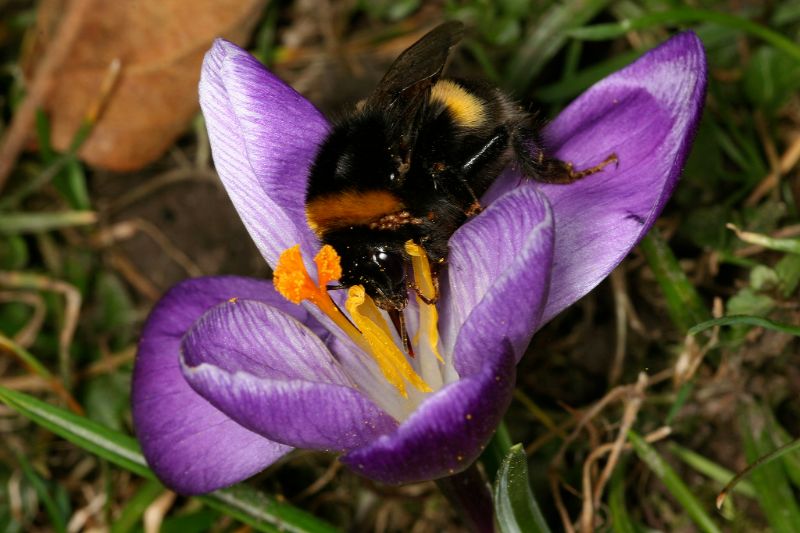Most wild bee hotspots are outside protected areas
The more than 20,000 species of wild bees worldwide are indispensable pollinators. Due to their different needs, food preferences and activity times they pollinate a wide range of flowers, and they improve the fruit set of agricultural crops even where there are many honeybees. About 600 species of wild bees are native to Switzerland. According to the Red List of Threatened Species almost half of them are endangered.
Do protected areas protect wild bees?
One problem is lack of habitat - and it is still unclear how well wild bees benefit from protected areas such as nature reserves. "When protected areas are established, the focus is usually on vertebrates or plants, not insects," says ecologist Joan Casanelles-Abella of the Swiss Federal Institute for Forest, Snow and Landscape Research WSL. Casanelles-Abella, Marco Moretti and researchers from other institutions investigated this question - with sobering results.
First, they explored where there is a particularly high wild bee diversity or where there are species that are particularly worthy of protection because they are rare or highly specialized. To do this, they used data from almost 3350 areas where long-term observations or studies had recorded which wild bees occur there. They then extrapolated these specific occurrences to the entire area of Switzerland for almost 550 bee species with the help of distribution models that included the location, land-use and climate of the sites. They then compared the species composition and characteristics of wild bee communities at different locations throughout Switzerland.
Differences between lowlands and mountains
Areas where a particularly large number of bee species lived, or whose bee communities were unique in terms of characteristics or composition and thus worthy of protection were defined as "bee hotspots". Contrasting trends emerged in the lowlands and in the mountains. Hotspots in the lowlands are characterized by a high species diversity. However, there were no hotspots with rare and highly specialized species that clearly differ from the rest of Switzerland. In the mountains, it was exactly the opposite: there, the researchers identified hotspots with species communities that stood out strongly from others due to rare and specialized wild bee species. Species diversity, on the other hand, was generally lower than in the lowlands.
In a further step, the researchers then investigated how much overlap there was between the wild bee hotspots they identified and nature conservation areas in Switzerland. "In strictly protected areas such as the Swiss National Park, the overlap is good," says Casanelles-Abella. Moreover, about half of the "mountain hotspots" are in protected areas. "This is because there are many protected areas in the Alps," the researcher explains.
Monitor hotspots
Viewed over the whole of Switzerland, however, most hotspots are located outside protected areas: For those with particularly rich species, the figure is over 75 per cent; for those with particularly unique species, it is still a good half. "The reason for this is that strictly protected areas make up only a small part of the country's territory," warns the researcher. "At the very least, these unprotected hotspots must be kept under close observation, and even better included in the network of existing protected areas, if that is possible." Researchers are also concerned about hotspots in the mountains, even if they are located in protected areas: "Especially at higher altitudes, climate change is progressing rapidly," says Casanelles-Abella. "In the Pyrenees, you can already see that species are disappearing at high altitudes."
In addition, it is now necessary to check with on-site investigations whether the bee diversity is actually high in the hotspots predicted by the model - and what sets them apart. This knowledge could then be used in the planning of protected areas that would also benefit wild bees, says Casanelles-Abella. "And not only bees - our method can also be transferred to other insects, allowing us to investigate where their hotspots are located.
The term "protected area" is an overarching term that covers many different strategies in Switzerland and reflects different levels of legislation (European/international, national, cantonal). Protected areas vary greatly in terms of management intensity and protection measures. In this study, a distinction was made between the following two categories:
- Protected areas sensu stricto: Swiss national park, biotopes of national importance (raised bogs and fens, floodplains, amphibian spawning areas, mire landscapes and dry meadows and pastures), forest reserves and Pro Natura nature reserves.
- Protected areas sensu lato: Swiss parks, waterbird and migratory bird reserves, federal hunting reserves and other protected areas of international importance such as “Smaragd-Gebiete”
